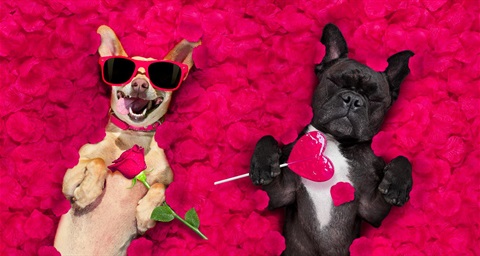Looking after your pets this Valentines Day
Published on 14 February 2022

If you want to do something truly romantic this Valentines Day, you should consider adopting a dog or cat that is in desperate need of a forever home.
Did you know that just spending 15 to 30 minutes with an adorable dog or cat can leave you feeling calmer, happier, more relaxed - and can relieve everyday stress?
The benefits of spending time together with your dog or cat are endless!
Valentines Day treats you may not realise are hazardous to your pet
As we busy ourselves spritzing perfume and getting dressed up for a hot date this Valentines Day, its important not to forget about our pets.
The best way to show love and care to your doting companions is by keeping them safe and happy.
Sadly, a lot of the traditional food and gifts associated with 14 February aren’t pet friendly, so keeping them away from these hazards is a good place to start.
Keep the following items out of their reach:
1. Lilies
If you receive a bunch of lilies this V-Day, it’s important to do two things.
- Firstly, say thank you (that’s just basic manners!).
- Secondly, it’s best you don’t bring the bouquet home.
Lilies are highly toxic to cats and can cause life-threatening illness or death. Ingesting any part of the plant, or even lapping up the water the flowers are steeped in, can cause complete kidney failure rapidly. The toxicity can occur by ingestion of, or even just mouthing, very small amounts of lily material.
Avoid all lilies but some specific examples to avoid include Asian, day, Easter, glory, Japanese show, peace, red, rubrum, stargazer, tiger, and wood lilies.
If you think there’s any chance your pet came into contact with a lily, take them straight to a vet or animal emergency hospital immediately.
2. Roses
Everyone wants to receive a red rose on Valentines Day! And dogs and cats are no exception.
However, stepping on or ingesting a thorny stem can puncture your little mate's paws or throat.
Play it safe by keeping roses trimmed and on a counter, well away from playful paws.
3. Chocolate and lollies
The classic Oreos ad did a good job of letting us all know that ‘chocolate isn’t good for dogs’, but it failed to mention the popular Valentines gift is harmful to cats too.
Toxins found in chocolate include agents like caffeine and theobromine, are extremely toxic to dogs and cats. Ingestion of chocolate can result in vomiting, diarrhoea, hyperactivity, seizures, increased heart rate and potentially death.
Sugar substitutes found in certain lollies and other sweet goods is another extremely dangerous ingredient to be mindful of because it can cause pet deaths.
If you think your pet may have pawed their way into your heart-shaped box of chocolates or lollies, take them to your vet or emergency animal hospital immediately.
4. Wine, cocktails and beer
While alcohol may bring a lot of joy to us, it’s obviously not intended to be shared with our pets.
If you find yourself getting a little too enthusiastic on the juice, make sure you don’t spill any alcohol on the ground, or leave any glasses unattended. Cats and dogs may lap it up, causing serious harm to their tiny stomachs and internal systems.
Symptoms of alcohol poisoning in pets include depression, incoordination, disorientation, vomiting, difficulty breathing, and potentially death.
5. Gift wrapping
After you’ve opened all the – hopefully numerous – presents you’ve received, make sure you gather up all the wrapping paper, ribbons, deflated balloons, or streamers.
Curious cats and dogs may try to play with, chew on, or swallow rogue Valentines decorations (just to try and be part of the fun, of course!).
By clearing them away, you’re helping your pets avoid a hazardous situation and you’re helping yourself get on top of the mess. Win-win.
6. Candles
While leaving a candle unattended is a general no-no, those with pets should be especially mindful of this advice.
Not only can pets knock over lit candles, they could potentially burn their sweet little paws on the wax or flame.
Best to avoid this entirely by keeping candles out of reach and only lit when you’re around.